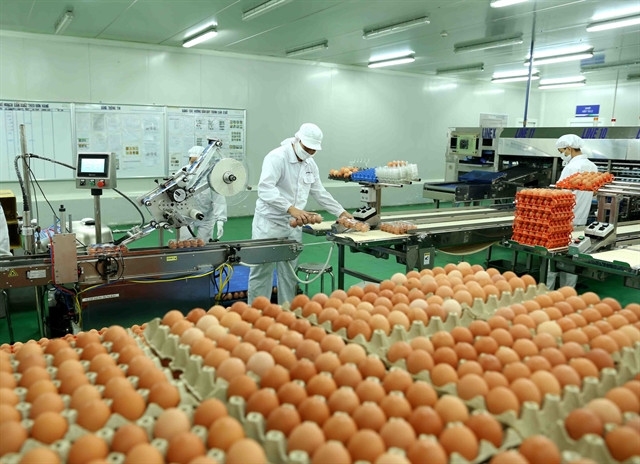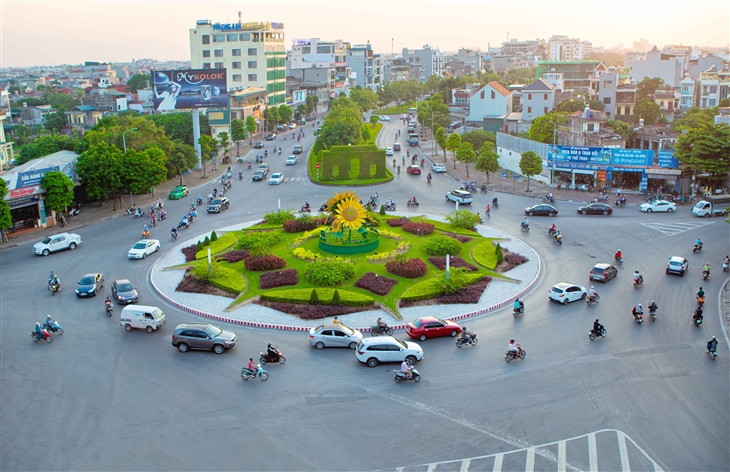In 2024, livestock product exports reach more than 533 million USD
Tuesday, January 21,2025
AsemconnectVietnam - In 2024, export turnover of livestock products reach more than 533 million USD. Vietnam has exported more than 1 billion USD of animal feed and raw materials for animal feed.
Many targets are ahead of schedule
According to report of Department of Animal Husbandry (Ministry of Agriculture and Rural Development), by the end of 2024, livestock industry has achieved and exceeded many targets compared to targets set for 2025 (according to Livestock Development Strategy for a period of 2021 - 2030, vision 2045).
Specifically, annual growth rate of production value reached 5.4% (target from 4 - 5%/year); output of domestically produced meat of all kinds reached 5.6 - 5.8 million tonnes (target from 5 - 5.5 million tonnes); egg output was more than 20 billion eggs (target from 18 - 19 billion eggs); average livestock products/person/year: Meat 56 - 57kg (target from 50 - 55kg), 220 eggs (target from 180 - 190 eggs); total pigs regularly present were over 31 million (target by 2030 from 29 - 30 million); silkworm cocoons were more than 18,000 tonnes (target by 2030 is 10,000 tonnes); export turnover of livestock products reached over 533 million USD (up 6.5%). In 2024, Vietnam also exported more than 1 billion USD of animal feed and feed ingredients. In addition, output of industrial animal feed reached more than 21 million tons (up 3.4%). Most prices of animal feed ingredients tend to decrease compared to the same period in 2023.
Notably, after a long period of opening market, up to now, the General Administration of Customs of China has licensed 11 Vietnamese factories to export to China. Thanks to that, output of milk and dairy products exported to China has continuously grown.
At the same time, after signing Protocol on exporting Vietnamese bird's nests and bird's nest products to China, 9 Vietnamese enterprises have been licensed to export products to this market. Processed chicken is also exported to Japan, Hong Kong (China), 5 countries in Eurasian Economic Union and Mongolia.
In addition to the products that have been and are being exported, Ministry of Agriculture and Rural Development is currently actively negotiating with competent authorities of a number of countries to promote export of Vietnamese livestock products such as: Negotiating with Korea on food safety conditions for poultry meat products; negotiating with Japan on conditions and procedures for exporting milk and dairy products to this market; continuing to negotiate to increase the number of manufacturing enterprises permitted to export to opened markets...
The fact that Vietnam has livestock products exported to many markets has affirmed quality of Vietnamese products. Diversifying export markets and opening up new markets with much room such as the Halal market is considered the key to boosting exports in general and livestock products in particular.
Improving the internal capacity of the livestock industry
In 2025, livestock industry aims to increase production value of entire industry by about 4 - 5% compared to 2024. Proportion of livestock in the overall agricultural sector is estimated at 28 - 30%. Total output of fresh meat of all kinds will reach over 8.6 million tons (up 4.5%); output of fresh pork reach over 5.4 million tonnes (up 5%); output of poultry meat reach over 2.53 million tons (up 4.2%); output of eggs of all kinds will reach about 21 billion eggs (up 4%); output of milk will reach over 1.25 million tonnes (up 4.8%); output of honey will reach 26,000 tonnes (up 9.2%); output of converted industrial animal feed will reach over 22 million tonnes (up 2.6%).
Many assessments recognize that there is still much room for the domestic livestock industry. However, according to Mr. Nguyen Xuan Duong - Chairman of Vietnam Livestock Association, the livestock farming space is getting narrower.
Mr. Nguyen Xuan Duong analyzed that we have reached limit in terms of livestock farming scale (number of pigs ranks 6th in the world; waterfowl ranks 2nd in the world; herd of buffaloes and cows is over 10 million...). Meanwhile, area for livestock farming is limited; climate change is increasingly unpredictable; pressure to protect environment is great, especially livestock industry must actively participate in the country's general strategy, implementing the Government's commitments to reduce greenhouse gas emissions.
At the same time, although number of livestock in the country is still increasing, the loss due to epidemics and natural disasters is quite large. Livestock is the industry that incurs the most costs such as disease prevention, labor, high feed prices... making domestic livestock farming costs higher than imported meat, leading to amount of meat from outside entering the domestic market still increasing. According to statistics, currently, domestic meat production increases by 2% each year, while imported meat increases by 15-20%. In particular, in coming time, import of livestock products will certainly increase as import tax is gradually decreasing to 0%. Mr. Phung Duc Tien - Deputy Minister of Agriculture and Rural Development - noted that, in face of increasingly high demands from markets and fierce competition, while our livestock science and technology are very limited, Department of Livestock, Institute of Animal Husbandry... when building research projects, topics, projects, and programs must aim for novelty, keeping up with the world's science and technology and digital transformation trends to avoid falling behind.
In particular, in general global trend towards safe livestock production and emission reduction, Department of Livestock Production needs to advise on the development of mechanisms and policies, and evaluate and replicate effective biosafety and circular livestock models; encourage development of chains linking businesses with businesses, businesses with people to facilitate strict control of all stages in the production process. Thereby, gradually improving domestic livestock production and attracting more investment resources from outside.
Source: Vitic/ congthuong.vn
According to report of Department of Animal Husbandry (Ministry of Agriculture and Rural Development), by the end of 2024, livestock industry has achieved and exceeded many targets compared to targets set for 2025 (according to Livestock Development Strategy for a period of 2021 - 2030, vision 2045).
Specifically, annual growth rate of production value reached 5.4% (target from 4 - 5%/year); output of domestically produced meat of all kinds reached 5.6 - 5.8 million tonnes (target from 5 - 5.5 million tonnes); egg output was more than 20 billion eggs (target from 18 - 19 billion eggs); average livestock products/person/year: Meat 56 - 57kg (target from 50 - 55kg), 220 eggs (target from 180 - 190 eggs); total pigs regularly present were over 31 million (target by 2030 from 29 - 30 million); silkworm cocoons were more than 18,000 tonnes (target by 2030 is 10,000 tonnes); export turnover of livestock products reached over 533 million USD (up 6.5%). In 2024, Vietnam also exported more than 1 billion USD of animal feed and feed ingredients. In addition, output of industrial animal feed reached more than 21 million tons (up 3.4%). Most prices of animal feed ingredients tend to decrease compared to the same period in 2023.
Notably, after a long period of opening market, up to now, the General Administration of Customs of China has licensed 11 Vietnamese factories to export to China. Thanks to that, output of milk and dairy products exported to China has continuously grown.
At the same time, after signing Protocol on exporting Vietnamese bird's nests and bird's nest products to China, 9 Vietnamese enterprises have been licensed to export products to this market. Processed chicken is also exported to Japan, Hong Kong (China), 5 countries in Eurasian Economic Union and Mongolia.
In addition to the products that have been and are being exported, Ministry of Agriculture and Rural Development is currently actively negotiating with competent authorities of a number of countries to promote export of Vietnamese livestock products such as: Negotiating with Korea on food safety conditions for poultry meat products; negotiating with Japan on conditions and procedures for exporting milk and dairy products to this market; continuing to negotiate to increase the number of manufacturing enterprises permitted to export to opened markets...
The fact that Vietnam has livestock products exported to many markets has affirmed quality of Vietnamese products. Diversifying export markets and opening up new markets with much room such as the Halal market is considered the key to boosting exports in general and livestock products in particular.
Improving the internal capacity of the livestock industry
In 2025, livestock industry aims to increase production value of entire industry by about 4 - 5% compared to 2024. Proportion of livestock in the overall agricultural sector is estimated at 28 - 30%. Total output of fresh meat of all kinds will reach over 8.6 million tons (up 4.5%); output of fresh pork reach over 5.4 million tonnes (up 5%); output of poultry meat reach over 2.53 million tons (up 4.2%); output of eggs of all kinds will reach about 21 billion eggs (up 4%); output of milk will reach over 1.25 million tonnes (up 4.8%); output of honey will reach 26,000 tonnes (up 9.2%); output of converted industrial animal feed will reach over 22 million tonnes (up 2.6%).
Many assessments recognize that there is still much room for the domestic livestock industry. However, according to Mr. Nguyen Xuan Duong - Chairman of Vietnam Livestock Association, the livestock farming space is getting narrower.
Mr. Nguyen Xuan Duong analyzed that we have reached limit in terms of livestock farming scale (number of pigs ranks 6th in the world; waterfowl ranks 2nd in the world; herd of buffaloes and cows is over 10 million...). Meanwhile, area for livestock farming is limited; climate change is increasingly unpredictable; pressure to protect environment is great, especially livestock industry must actively participate in the country's general strategy, implementing the Government's commitments to reduce greenhouse gas emissions.
At the same time, although number of livestock in the country is still increasing, the loss due to epidemics and natural disasters is quite large. Livestock is the industry that incurs the most costs such as disease prevention, labor, high feed prices... making domestic livestock farming costs higher than imported meat, leading to amount of meat from outside entering the domestic market still increasing. According to statistics, currently, domestic meat production increases by 2% each year, while imported meat increases by 15-20%. In particular, in coming time, import of livestock products will certainly increase as import tax is gradually decreasing to 0%. Mr. Phung Duc Tien - Deputy Minister of Agriculture and Rural Development - noted that, in face of increasingly high demands from markets and fierce competition, while our livestock science and technology are very limited, Department of Livestock, Institute of Animal Husbandry... when building research projects, topics, projects, and programs must aim for novelty, keeping up with the world's science and technology and digital transformation trends to avoid falling behind.
In particular, in general global trend towards safe livestock production and emission reduction, Department of Livestock Production needs to advise on the development of mechanisms and policies, and evaluate and replicate effective biosafety and circular livestock models; encourage development of chains linking businesses with businesses, businesses with people to facilitate strict control of all stages in the production process. Thereby, gradually improving domestic livestock production and attracting more investment resources from outside.
Source: Vitic/ congthuong.vn
Sharp increase in turnover creates great opportunities for exporting pangasius to US
DAILY: Vietnamese live hog prices remained steady on January 20, 2024
Rice Prices on January 20: Export Prices Drop to Two-Year Lows
DAILY: Vietnamese coffee prices increased by 500-1000 VND per kg on January 20, 2024
Binh Dinh province aims to attract 45 projects into IZs
Trade with China hits record of 200 billion USD, Vietnam's deficit is getting bigger
Long-term industrial growth solutions
Vietnam's fertilizer exports earn over 700 million USD
DAILY: Vietnamese pepper prices remained unchanged on January 17, 2024
DAILY: Vietnamese coffee prices decreased by 600 VND per kg on January 17, 2024
7.7 billion USD for importing raw materials for animal feed
Vietnam’s major economic indexes in 2024
Pangasius exports in 2024 and targets for 2025
In 2024, pepper exports to the US increased to a record high

Plan of Hai Duong province for a period of 2021 - 2030, ...
Organize space reasonably and harmoniously, focusing on connecting Hai Duong in common development space, actively contributing to the ...Plan of Hau Giang province in a period of 2021 - 2030, ...
Sustainable forestry development program in a period of ...

Outstanding aquatic sport athletes honoured
More than 100 Vietnamese outstanding aquatic sport athletes were honoured at an event held in the southern province of Tay Ninh on ...Traditional music bridges Vietnamese, Chinese youth
Vietnamese player wins regional table tennis championships



